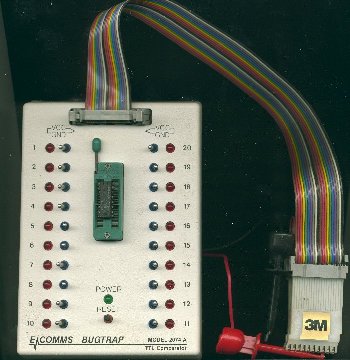Pac-man Repair & Troubleshooting Guide
Content originally created by Lawnmowerman
Bug Trap

The BugTrap is a chip comparator. It works by using a known good chip, which is inserted into the bug trap. The toggle switches are thrown to remove the voltage pins. The white end clips on the suspect chip. The red & black test leads clip to voltage source (+5 & GND for TTL). The reset button is toggled and we look for red LEDs to light indicating a mis compare between the chip in circuit & the known good chip in the BugTrap.
While it may seem that this approach will find any faulty chip on your problem PCB it will not. It will have problems overloading outputs or dragging down inputs in some designs.
It will not find missing inputs caused by broken traces or bad sockets.
Ram chips will need to be analyzed from start up.
Some chips require a manual reset with a ground wire.
The Bug Trap does shine on certain situations, especially "one-shot" occurances that are hard to find without a scope set up to trigger on given events (and then you must know what event you are looking for).
Bug Traps retail in the $300.00 range. There are 2 common types, TTL & CMOS (outward appearance is identical to above).
Bug Traps will not make a newbie technician a wizard, will not find many problems used alone, are handy in a few circumstances (example the logic portion of Pac-Man audio may easily be checked with a Bug Trap succesfully). All in all I personally belive that a bug tap is a nice addition to a work bench if you have the $ to spend but has a very low return on investment.